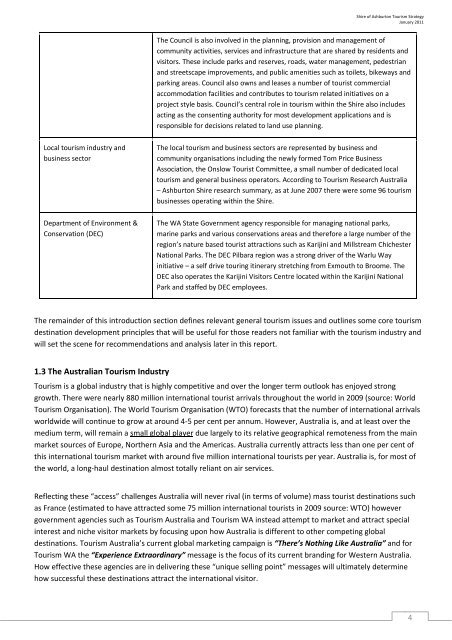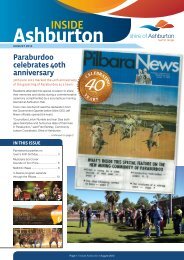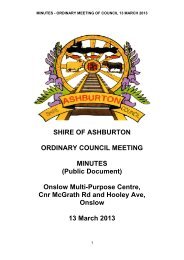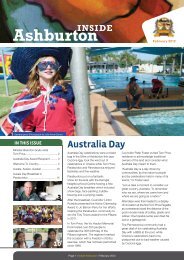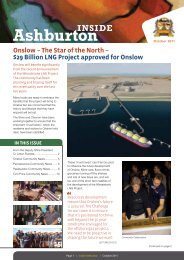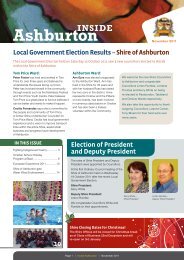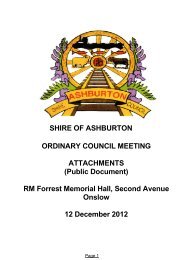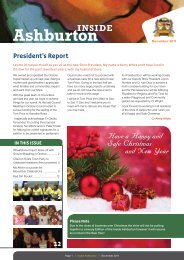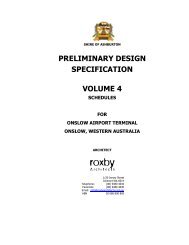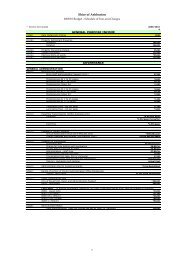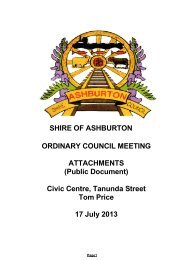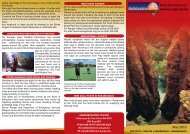Part 1 - Shire of Ashburton
Part 1 - Shire of Ashburton
Part 1 - Shire of Ashburton
You also want an ePaper? Increase the reach of your titles
YUMPU automatically turns print PDFs into web optimized ePapers that Google loves.
<strong>Shire</strong> <strong>of</strong> <strong>Ashburton</strong> Tourism Strategy<br />
January 2011<br />
The Council is also involved in the planning, provision and management <strong>of</strong><br />
community activities, services and infrastructure that are shared by residents and<br />
visitors. These include parks and reserves, roads, water management, pedestrian<br />
and streetscape improvements, and public amenities such as toilets, bikeways and<br />
parking areas. Council also owns and leases a number <strong>of</strong> tourist commercial<br />
accommodation facilities and contributes to tourism related initiatives on a<br />
project style basis. Council’s central role in tourism within the <strong>Shire</strong> also includes<br />
acting as the consenting authority for most development applications and is<br />
responsible for decisions related to land use planning.<br />
Local tourism industry and<br />
business sector<br />
Department <strong>of</strong> Environment &<br />
Conservation (DEC)<br />
The local tourism and business sectors are represented by business and<br />
community organisations including the newly formed Tom Price Business<br />
Association, the Onslow Tourist Committee, a small number <strong>of</strong> dedicated local<br />
tourism and general business operators. According to Tourism Research Australia<br />
– <strong>Ashburton</strong> <strong>Shire</strong> research summary, as at June 2007 there were some 96 tourism<br />
businesses operating within the <strong>Shire</strong>.<br />
The WA State Government agency responsible for managing national parks,<br />
marine parks and various conservations areas and therefore a large number <strong>of</strong> the<br />
region’s nature based tourist attractions such as Karijini and Millstream Chichester<br />
National Parks. The DEC Pilbara region was a strong driver <strong>of</strong> the Warlu Way<br />
initiative – a self drive touring itinerary stretching from Exmouth to Broome. The<br />
DEC also operates the Karijini Visitors Centre located within the Karijini National<br />
Park and staffed by DEC employees.<br />
The remainder <strong>of</strong> this introduction section defines relevant general tourism issues and outlines some core tourism<br />
destination development principles that will be useful for those readers not familiar with the tourism industry and<br />
will set the scene for recommendations and analysis later in this report.<br />
1.3 The Australian Tourism Industry<br />
Tourism is a global industry that is highly competitive and over the longer term outlook has enjoyed strong<br />
growth. There were nearly 880 million international tourist arrivals throughout the world in 2009 (source: World<br />
Tourism Organisation). The World Tourism Organisation (WTO) forecasts that the number <strong>of</strong> international arrivals<br />
worldwide will continue to grow at around 4‐5 per cent per annum. However, Australia is, and at least over the<br />
medium term, will remain a small global player due largely to its relative geographical remoteness from the main<br />
market sources <strong>of</strong> Europe, Northern Asia and the Americas. Australia currently attracts less than one per cent <strong>of</strong><br />
this international tourism market with around five million international tourists per year. Australia is, for most <strong>of</strong><br />
the world, a long‐haul destination almost totally reliant on air services.<br />
Reflecting these “access” challenges Australia will never rival (in terms <strong>of</strong> volume) mass tourist destinations such<br />
as France (estimated to have attracted some 75 million international tourists in 2009 source: WTO) however<br />
government agencies such as Tourism Australia and Tourism WA instead attempt to market and attract special<br />
interest and niche visitor markets by focusing upon how Australia is different to other competing global<br />
destinations. Tourism Australia’s current global marketing campaign is “There’s Nothing Like Australia” and for<br />
Tourism WA the “Experience Extraordinary” message is the focus <strong>of</strong> its current branding for Western Australia.<br />
How effective these agencies are in delivering these “unique selling point” messages will ultimately determine<br />
how successful these destinations attract the international visitor.<br />
4


